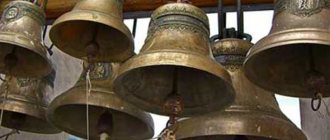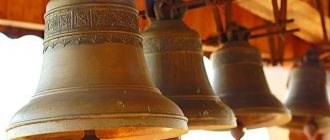First view: the actual ringing
Actually, church ministers call ringing the ringing of bells, which is produced using all existing or several church bells. This ringing is divided into several varieties: - trezvon; - double ringing; - call back; - overkill.
When beating, after striking a large bell, all the bells are struck at once and this is repeated many times.
Double ringing - this ringing is the name given to the strikes that are made twice on all the bells. At the same time, the bells are rung in two stages. Chime is the alternate extraction of sound from a bell, which begins with the largest and ends with the smallest.
Picking is a slow ringing of each bell once in turn, starting with the smallest and ending with the largest.
The second type of bell ringing: blagovest
Church ministers call the gospel the measured strikes of a huge bell. This type of impact can be heard very well over a long distance. That is why church workers decided to use this bell ringing to call people to worship.
Such a ringing was called the Blagovest because with its help the good news about the beginning of the divine service is announced.
The gospel is carried out in a certain way. First, the church minister makes three slow and drawn-out blows, waiting for the sound to fade, and then makes more measured blows. In this case, the impact effects may differ, depending on the size of the bell itself. If it is relatively large, they are produced along the entire diameter of the bell. If it is not very large, the tongue of the bell is simply pulled with a rope to its edge and, using a placed board, strikes are made by pressing the foot.
If there are several large bells at the temple, and this is possible in large monasteries, cathedrals, laurels, then large bells, depending on their purpose, are divided into several types: - Sunday; - festive; - everyday (simple day-to-day); - polyeleous; - small.
Source
Types of bells
In an essay or report on bells, you can also write about the main varieties. There are only three of them, based on the size of the instruments:
- large;
- small;
- average.
Large bells are also called evangelists . Their ringing alerts parishioners to the start of the service. They can be holidays, Sundays, fasts, or just daily ones. The first ones are used during the main Orthodox celebrations. They are rung at Easter, Christmas, and the Annunciation. The latter apply only on Sundays, hence the names. And the third type can only be heard during fasting. The common day bells ring daily. There are also polyeleos that play during the corresponding service.
Small devices are also called bell devices . These are small-sized instruments, usually they are combined into one complex. Most often they are used in conjunction with large bells to achieve ringing. They play once before the evening service, twice before the morning service, and three times the small bells ring at the beginning of any Divine Liturgy.
Middle or ringing devices are intended only to decorate the overall sound. This is worth talking about in a music message about bells for 5th grade or in Sunday school lessons. These instruments are larger than small ones. But they are also bundled together and attached to a lamp post.
Their sound is heard during Easter Lent or as a symbol of the liturgy. Also, ringing bells are used in bells, chimes, double rings and trezvon.
Use of bells
The prototype of today's bells are small Chinese bells made in the 23rd–17th centuries BC. Later, the masters of the Celestial Empire created a musical instrument based on them, which then became an analogue of the European carillon. For a long time, the Old World did not recognize this device, as it associated it with paganism.
Construction of a typical European bell
The carillon became a symbol of the church only in the Middle Ages. It was engraved with passages from the Gospel, and the individual components were named after human parts of the body: tongue, ears, body, lip. At the same time, the tradition of consecrating the bell arose, which later migrated to Rus'.
People believed that the melodic chime could scare away evil spirits, and sometimes even bring healing. Today, bells can be found in almost all religions and beliefs. For example, shamans still use this tool to drive out evil spirits.
Bells in the Russian Orthodox Church
Belfries in Rus' began to be built immediately after its Epiphany. For the first few centuries, Russia produced European carillons, but by the 15th century it began making its own. The ringing, heard throughout the surrounding area, invited parishioners to a service, a public meeting, or notified of trouble. Local craftsmen cast larger samples to enhance the sound produced. Thus, the prototype of the famous “Tsar Bell” weighed about 208 tons.
Until the beginning of the 20th century, casting was carried out at state factories, but after the October Revolution the sphere passed into private hands. Such production did not last long - until the 30s. It was possible to resurrect the foundry business only after “perestroika”, setting the task for two factories: ZIL and Baltiysky. Today, church carillons consist of three types of bells: large, medium, small.
Belfries in Rus' began to be built immediately after Epiphany
Large
Evangelists are called upon to notify parishioners about the beginning of the service. They are divided into several types:
The evangelists also include “hour” bells that sound every hour.
Small
Small or ringing bells are small bells united together into one bunch. As a rule, they are used together with large bells to perform trezvon:
Average
Ringing bells are intended for only one thing - decorating the overall sound. They are slightly larger than the bells and are connected to each other in the same way by chains attached to the bell post. More often, the sound of middle bells can be heard during the ringing of Easter Lent or before the Liturgy of the Presanctified Gifts. They also participate in ringing, ringing, double ringing or chiming.
Russian church
In any message about bells, it is worth briefly indicating how they became famous in Rus'. The first belfries began to be erected in the state immediately after the baptism. European carillons were used for several centuries, but by the 15th century new devices appeared. Throughout the area, a sound could be heard that gathered parishioners for services or notified them of an enemy attack. Local artisans cast instruments of considerable size so that they would produce a loud sound. For example, the Tsar Bell prototype weighed 208 tons.
By the beginning of the 20th century, only state factories were engaged in casting. But after the October Revolution, this business passed to the owners of private enterprises. Although production did not last long.
Due to the fact that the communists reproached religion, they stopped building churches and belfries. And therefore the bells were no longer needed. Only after perestroika the foundry business was revived.
It was assigned to only two plants - Baltic and ZIL. They made instruments of different sizes. But only three types were used in the church.
Placement of bells
The carillon used by the Orthodox Church is a simple structure suspended low from the floor on vertical posts. The instrument is very convenient to operate without much effort, but it is practically inaudible over a long distance.
So that the bell ringing could be heard several miles away, the belfry began to be installed separately from the temple building. Later they began to attach it directly to the cathedral, making it an integral part of the architectural complex. In the 19th century, the bell tower was located on the roof of the church itself. Since the latter was always erected higher than other buildings, the sound spread throughout almost the entire city.
Types of bell ringing
The beautiful melodic sound that we often hear on holidays comes in several types.
Blagovest
It represents single, measured strikes on a large bell. First, the bell ringer slowly plays three long ringing sounds, and after they die down, he continues to ring with even pauses. You can hear the gospel on great church festivals or during Easter Lent.
Chime
The shimmering, solemn chime is usually used before particularly significant sacred ceremonies: the Epiphany service, the Divine Liturgy, etc. In it you can hear all three types of bells, which ring in turn, forming a joyful, bright melody.
Bust
This is a mournful ringing in a minor key. It is used during requiem or funeral services. First, the bell ringer slowly strikes each instrument in turn: from the bell ringer to the evangelist. After the last sound subsides, he begins to ring all the bells, repeating this order several times.
Varieties of bell ringing in Orthodoxy
Trezvon
It is displayed by analogy with brute force, that is, it includes all the tools at once. People call it “Breaking Bad.” The clergyman takes up the carillon three times, taking short breaks between sessions.
Alarm
Today the alarm is a rather rare phenomenon. During the times of Rus', it was used much more often, notifying the laity about upcoming or already occurring terrible events. As a rule, single, alarming sounds coming from the bell tower meant some kind of natural disaster, fire or raid by an enemy army.
The ringing of bells can be called an invariable attribute of Orthodoxy, and the bell is a symbol of the church. Since the 10th century, it has been used on the occasion of joyful and sometimes sad events. This tradition has survived to this day, and therefore on every church holiday we hear a joyful, solemn chime.
If you find an error, please select a piece of text and press Ctrl+Enter.
Source
Different regions of Russia have their own styles and types of bell ringing. For a long time, Moscow, Ivanovo, Rostov, Pskov and other bells have been distinguished. Nowadays, bell ringing depends on the personal taste and skills of the individual bell ringer. In Moscow you can hear not only the Moscow ringing (which is followed, for example, in the Novodevichy Convent). For example, in the Cathedral of Christ the Savior and in the Kremlin, they adhere to Rostov bells.
The sound of bells is influenced by the materials from which they are cast, as well as the shape of the dome. The thickness of the side walls of the bell determines mainly the strength of the sound, its purity and duration.
The distinctive features of Russian bells are their sonority and melodiousness. This became possible by using the optimal proportion of tin and copper in the alloy. It is typical for Europe to obtain sound by swinging the bell dome itself. In the 20th century, in Western European countries there was a tendency to use electronic ringing. With the help of an electric motor, the bell rotates, the tongue swings, resulting in a blow.
For bells in Russian churches, a fixed mounting method is usually used. The domes are stationary, and the sound is achieved using a tongue freely swinging inside the dome.
Bell ringing: different types For each church service there is a special bell ringing: bell ringing, trezvon, perezvon, perezvon. In 2002, the Russian Orthodox Church adopted the “Charter Ringing Charter”. It contains information about the types of ringing, how to initiate bell ringers, consecrate and store bells.
Blagovest Blagovest - ringing with measured strokes of one large bell. First, two blows are made until the sound completely subsides, and from the third - measured blows. The duration of the ringing is 10-20 minutes. The Blagovest announces the beginning of the service. The same ringing is used during the most important moments of a church service.
Trezvon Trezvon is the ringing of all the bells. People say about him that they are calling “in all seriousness.” This most solemn type of ringing is performed in three steps. Used on major holidays and other important church events. Sounds before the start of the service (after the gospel), before the reading of the Gospel and at the end of the service.
A type of trezvon is the “red ringing”. It is only possible where there are many large bells and several ringers. In the old days, medium-sized bells with a pleasant melodic ringing were called “red.”
Ringing with alternate strikes on each bell, starting with the largest and ending with the smallest, is called chime. This is both a solemn and mournful type of ringing. It is used to show the importance of the upcoming service. Therefore, chime is used only on certain days of Lent (Good Friday and Great Saturday) and when consecrating water on the feast of the Epiphany (January 19).
Bust Bust - ringing with alternate strikes on each bell, starting with the small one and ending with the big one. This type of bell ringing is also called funeral ringing and is used during the funeral service of the deceased.
Raspberry ringing The concept and phrase “raspberry ringing” is widely known. It has nothing to do with raspberries. The name comes from the French city of Malines - Malin (modern Mechelen, Belgium). Here, in the Middle Ages, craftsmen developed a successful alloy for casting bells that produced a “velvety” ringing. Over time, when such bells appeared in Russia, the beautiful, melodiously iridescent ringing began to be called “raspberry”. That is, “raspberry ringing” means “very pleasant, soft in timbre.”
What types of bells are there?
Common or frequent.
Lenten or rare - produced by a smaller bell, on the weekdays of Great Lent.
If there are several large bells at the temple, and this happens at cathedrals, large monasteries, laurels, then the large bells, in accordance with their purpose, are distinguished into the following bells: 1) festive; 2) Sunday; 3) polyeleous; 4) just everyday or everyday; 5) fifth or small bell.
The ringing of the trezvon expresses Christian joy and triumph.
In our time, trezvon began to be called not only ringing all the bells three times, but, in general, ringing all the bells.
2. Double ringing is ringing all the bells twice, in two steps.
3. Chime is ringing each bell in turn (one or several strikes on each bell), starting from the largest one to the smallest one, and repeating this many times.
4. Bustling is a slow ringing of each bell once in turn.
1 8 · Good answer
A set of bells?
If you're looking for a name for a set of bells, it's Carillon. It is a set of bells that sound to form a diatonic or chromatic scale.
What types of bells are there?
There are about 400 types of bells. Some are annual or biennial, but most are perennial.
Bells can also be divided into forest, meadow (field, steppe), and mountain.
Forest ones are quite large, both the bushes themselves and the corolla cup. They love partial shade, bloom closer to mid-summer: nettle-leaved bell, peach-leaved.
Meadows are usually medium in size, love open sunny areas: medium bell, Crimean.
Mountain ones are the smallest, grow well in a small volume of not the most fertile soil, so they are often used in landscaping rock gardens and rockeries: Scheichzer bell, birch leaf, gargan.
The shape and color of the corolla can be very different from simple single-corolla white (Carpathian bellflower) to dark purple “double” (the “cup and saucer” variety of the middle bell type).
They also differ in the size of the bush: from tiny 5-7 cm in height (Rainer's bell) to giants 1.5 meters (broad-leaved bell).
In gardens and plots there are often perennial and biennial species that are widely cultivated and can be represented by several dozen varieties.
From small ones up to 30 cm in height, they grow the Carpathian bell, Kemularia bell, Kamarov's bell, Pozharsky's bell, Portenschlag's bell.
Among the taller ones: crowded bell, round-leaved, spreading, peach-leaved, dotted, medium.
The tallest: Bolognese, broad-leaved, milky-flowered.
Does the place in the bell tower where the bells are actually located have a special name?
I don’t know about other languages, but in Orthodox churches this place is called the “belfry.” In Polish, by the way, too: dzwonnica (bell ringer, yes)
When creating disturbing music, ringing bells are often used. What is the reason for the effect? Does it affect representatives of certain cultures. Or is it universal?
What do you collect and why?
Sugar in bags, which are given in cafes, restaurants, airplanes, etc. At the moment, the collection contains 70+ pieces from different countries (not all are pictured). I just saw a photo of a huge similar collection and was inspired by the idea. And this turned out to be a good reason to go to new places every time and look for sugar.
Chinese traditions
Bells are used not only in Orthodox churches. The inhabitants of Kievan Rus gleaned a lot of information about them from China. This state has ancient traditions of casting devices. Other countries have adopted them. In modern China, these instruments are considered to belong to different types of temples. Although in the center of old cities special towers were erected, where signals were given twice a day - at dawn and at sunset.
Archaeologists have discovered that there were several types of bells in China. Modern models have a traditional round shape, but they originated more from India. And in the Middle Kingdom, instruments had a transverse almond-shaped cut. They made short sounds and could play two distinct tones. And their sets covered up to five octaves at once.
Even the principles of device placement are different in China . Some of them have the sounding part at the top. These bells have a long leg on which they stand. Others have a full foot, which makes their sound different from other species. But the golden age of Chinese bell making ended immediately after the Warring States period. Later, gigantic ritual devices were made, cast from metals obtained from the weapons of conquered states.
Today, bells are used in both religious and musical spheres. They are made from different metals and can come in all shapes and sizes.








